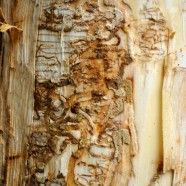Collaborative Forest Pest Project Update
They always say, pictures are worth 1,000 words. And in most cases I would agree with that. There is always an interesting story behind each photograph we take or view. Photographs can capture a joyous or disheartening scene, appeal to our emotions or bring our attention to someone or something in need. This past weekend, as a part of our joint Forest Pest Outreach Project with Cornell Cooperative Extension of Chautauqua County, Betsy Burgeson, my husband Tyler and I all got out to North Harmony State Forest to erect signs on Eastern Hemlock trees along the main snowmobile trail and cross...
Read MoreThanks Attendees! Collaborative Forest Pest Project Information Session
A big “thank you!” to everyone who attended our Collaborative Forest Pest Project Information Session this past Thursday night at the Roger Tory Peterson Institute of Natural History in Jamestown, New York. Here you can see RTPI Conservation Technician Elyse Henshaw who did a terrific job educating over 20 members of the public on devastating forest pests like Hemlock Woolly Adelgid (HWA), an aphid-like insect targeting Eastern Hemlock trees, and Emerald Ash Borer (EAB), a wood boring insect targeting all of our Ash trees. As these pests threaten Chautauqua County organizations...
Read MoreEarly Signs of Emerald Ash Borer
At about the size of a tic-tac, the Emerald Ash Borer (EAB) doesn’t seem like it could possibly do much harm; however, its size allows its invasion to often go undetected. The ash borer is a non-native wood boring beetle that is capable of causing thousands of dollars of damage to ash trees, which make up 10% of New York’s forest and are favorable for planting along street sides in urban centers and towns. With an invader that is so small and with so many trees, how is it possible to detect this unwelcome bug? Knowing the signs and symptoms can help catch this intruder early in...
Read MoreDowny Woodpecker (Picoides pubescens)
Downy Woodpeckers (Picoides pubescens) are a common sight in the region and can typically be seen hammering away at the bark of a tree, attempting to uncover a nice juicy larval insect. These woodpeckers aren’t terribly picky, and have recently been found to munch down Emerald Ash Borer (EAB) larvae, an invasive species of beetle attacking ash trees. As EAB has spread throughout several states, scientists have been seeing rising population numbers as a result of increased food resources in at least four bird species, including the downy woodpecker. While woodpeckers may have some...
Read MoreEmerald Ash Borer (Agrilus planipennis)
On Thursday afternoon I had the opportunity to be a part of an Emerald Ash Borer (EAB) 1st Detector’s Training led by the Cornell Cooperative Extension here in Jamestown. After a morning of learning the biology and ecology of this invasive insect, we had the opportunity to drive just a short 20 minutes away to Randolph where EAB has heavily infested countless ash trees. Pictured below is a larvae that is eating away at the soft tissues of the wood. By next spring this little larvae will emerge into an adult capable of flying to other ash trees and starting new infestations. Stay tuned...
Read More








